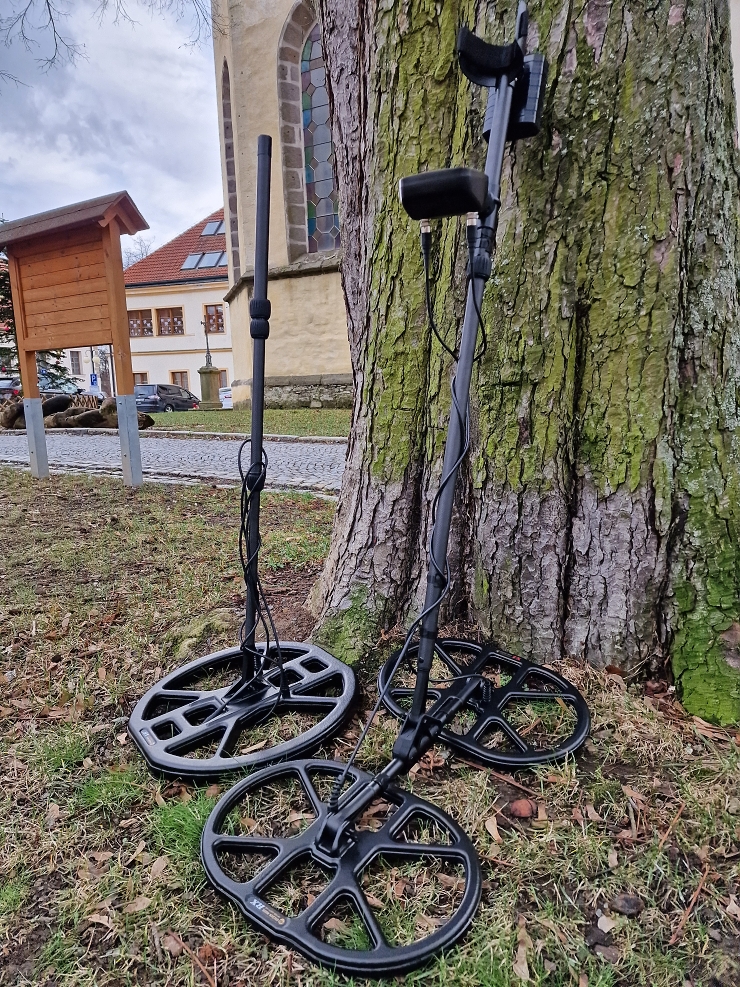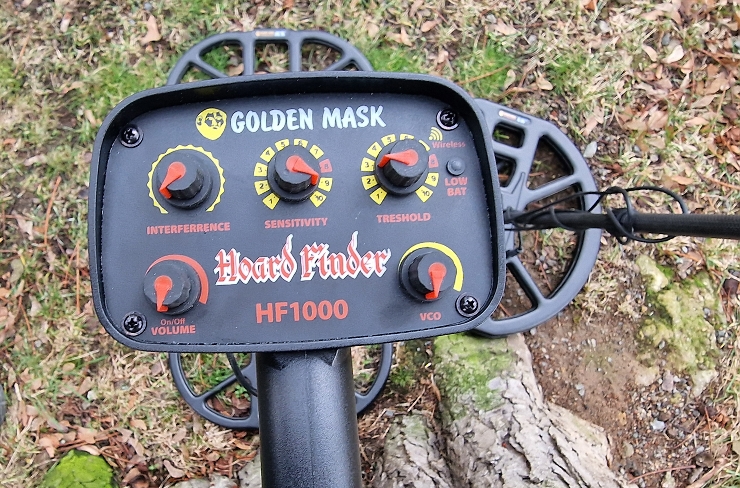White's TM 808 bylo IBčko. Jaký májí význam u PI dvě cívky. Když detektor nemá rozlišení kovů ? Marketing ?
New deep metal detector Golden Mask HF1000
Categories: Golden Mask - Reviews and tests

After a long time, a new pulse and 2box metal detector system Golden Mask HF1000 is now available. Information about it has been leaked for some time now, as the detector has occasionally appeared in test videos variously on the internet. However, the final version only went into production at the end of the year and so we now have the first production unit in stock.
As everyone is used to with Golden Mask, the GM HF 1000 is a very simple detector to operate. Setting it up is not a problem, you just need to "re-learn" a bit, as the movement with the PI is much slower than with a classic VLF detector. The detector is primarily designed to find medium and large targets at the greatest possible depths.
The detector now comes with a large 18" coil in the assembly as a classic detector or what would be a 2box detector with a dual 16x11" coil.

What kind of search is the Golden Mask HF 1000 designed for?
The detector is designed to search for medium to large targets at maximum depths. This is both when using a 2box coil and when using a large 18" conventional probe. The detector is not designed to search for small targets such as single coins etc. even when using a classic probe.
The depth range for large objects, we tested 20x20 cm is somewhat disarming and that is where the main scope of the detector lies. It should be remembered that the detector has no discrimination and the fact that small objects are missed is basically a necessity, otherwise the searcher would probably not move from his place.
The astonishing stability of the detector
Since we already have some experience with PI detectors, we can definitely highlight the stability of the HF1000, which is well above expectations. Even in the completely overcrowded environment of the city centre, the detector could be set to the recommended sensitivity level without hesitation. It can only be confirmed that the detector can also be easily used for "industrial" applications, such as searching for asphalt-encased water closures, sewer covers, etc.
We believe that the GM HF 1000 will quickly find its customers, both from the pyrotechnicians and the general public. At a time when, thanks to the discontinuation of the Whites TM 808, only the Fisher Gemini 3 remains on the market as a full-size 2box, there is a huge space for a similar detector.
LP detector page: Golden Mask HF 1000 2box
The article is included in categories:
Post
Doplnění. TM 808 není klasické IB, ale indukčně balanční princip je použitý. Je to patrné z uspořádání cívek.
No prece hloubku jedna civka vysila a druhá Prima.
PI funguje i s jednou cívkou. I s jednou cívkou se dá měřit vodivost kovů. Po utlumení indukce z pulzu se dá měřit, jak rychle zanikají vybuzené vířivé proudy v kovu pod cívkou a získat hrubé rozlišení. S druhou cívkou se dá vyhodnotit i fero/barevný kov.
Systém vysílací a přijímací cívky je u PI detektoru docela dlouho....Nejedná se tedy o marketingový tah 


Např. řada PI detektorů GPX od Minelabu umí pracovat s cívkami obou systémů jak MONO tak DD.
Když si sondu kupujete vybíráte si provedení MONO nebo DD.
Když detektor funguje v režimu mono cívka se synchonně s pulsy přepíná do z režimu vysílač/přijímač..
Pokud je to systém 2 cívek jedna logicky slouží jako vysílač a druhá jako přijímač separátně...
to je i případ této sondy na jedné sondě je nápis TX (vysílač) a na druhé RX (příjem)...každá sonda konektor s jiným počtem pinů aby to nebylo zaměnitelné.
GPX má rozlišení, navíc obě cívky jsou v jednom korpusu. Jako u IB s minimální vazbou mezi sebou.
Stále to nedává smysl. Pokud by měl detektor aspoň měření vodivosti. Chápal bych, že se jim nepodařilo včas utlumit indukční špičku a proto musí měřit druhou cívkou, ale to by mohli být souosé. Ale ty cívky nemají ani žádný náklon, aby indukce směřovala do nějakého "společného bodu". Cívka vypadá pěkně masivní a asi dost těžká. Cívka pro PI může být velmi lehká, protože nemusí být tuhá jako u IB, protože deformace nemá vliv na detekci.
Stále nám tu chybí nějaká utajovaná informace, aby to dávalo smysl. 
No minimálně můžou začít dřív měřit, pokud je cívka takhle daleko nebude přijímací cívku tolik ovlivňovat, pokud nebude utlumený budící puls. Tím vzroste i hloubkový dosah detektoru na velkē cíle. Jinak stejná vysilací i přijímací cívka nebude úplně optimalní, protože pro vysílaní potřebuješ vyšší výkon a průřez vodičů ve vysílací cívce může mít nežádoucí parazitní kapacitu. Pokud máš samostatnou cívku pro přijímač, máš možnost z toho vyrazit víc vzhledem k vyšší vstupní citlivosti.
Před časem bylo někde na YT video, kde tuhle dvojitou cívku předváděli. Tahalo to cíl z velké hloubky......








